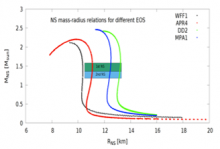
Abstract
Observations of X-ray binaries indicate a dearth of compact objects in the mass range from ∼2−5 M⊙ and the existence of this (first mass) gap has been used to advance our understanding of the engines behind core-collapse supernovae. LIGO/Virgo observations provide an independent measure of binary compact remnant masses and several candidate first mass gap objects (either NS or BH) were observed in the O3 science run. We study the formation of BH-NS mergers in the framework of isolated classical binary evolution. We use population synthesis method to evolve binary stars (Population I and II) across cosmic time. The predicted BH-NS mergers from the isolated classical binary evolution are sufficiently abundant (∼0.4−10 Gpc−3yr−1) in the local Universe (z≈0) to produce the observed LIGO/Virgo candidates. We present results on the NS to BH mass ratios (q=MNS/MBH ) in merging systems, showing that although systems with a mass ratio as low as q=0.02 can exist, only a small fraction (∼0.05%−5%) of LIGO/Virgo detectable BH-NS mergers have mass ratios below q=0.05. We find that with appropriate constraints on the (delayed) supernova engine ∼30−40% of LIGO/Virgo BH-NS mergers may host at least one compact object in the gap. The uncertainties in the processes behind compact object formation imply that the fraction of BH-NS systems ejecting mass during the merger is ∼0−9%. In our reference we find that only ∼0.2% of BH-NS mergers will have any mass ejection, and about the same percentage would produce kilonova bright enough to have a chance to be detected even with a large (Subaru-class) 8m telescope. Interestingly, all these mergers will have both BH and NS in the first mass gap.